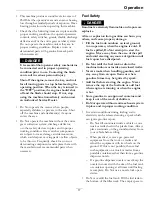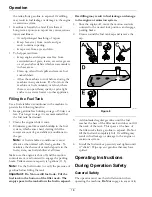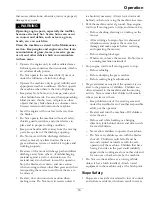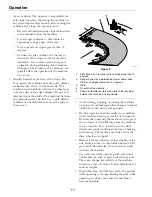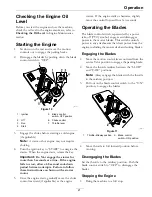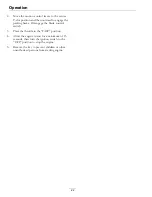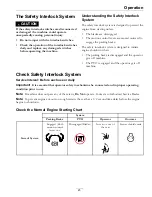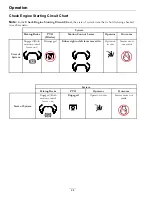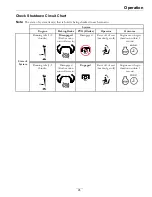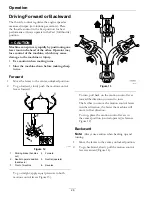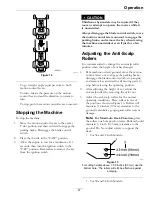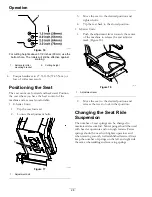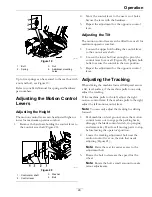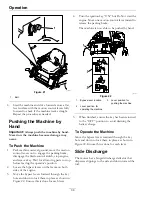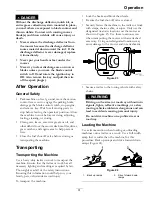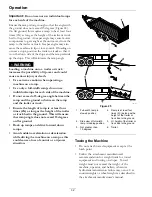
Operation
•
This machine produces sound levels in excess of
85 dBA at the operator’s ear and can cause hearing
loss through extended periods of exposure. Wear
hearing protection when operating this machine.
•
Check that the following items are in place and in
proper working condition: the operator presence
controls, safety switches, guards, shields, discharge
deflector and/or the entire grass catcher system.
Do not operate the machine unless they are in
proper working condition. Replace worn or
deteriorated parts with genuine Exmark parts
when necessary.
DANGER
It is essential that operator safety mechanisms
be connected and in proper operating
condition prior to use. Contacting the blade
can result in serious personal injury.
Shut off the engine, remove the key, and wait
for all moving parts to stop before leaving the
operating position. When the key is turned to
the “OFF” position, the engine should shut
off and the blade should stop. If not, stop
using the machine immediately and contact
an Authorized Service Dealer.
•
Do Not operate the mower when people,
especially children, or pets are in the area. Shut
off the machine and attachment(s) if anyone
enters the area.
•
Do Not operate the machine without the entire
grass collection system, discharge deflector,
or other safety devices in place and in proper
working condition. Grass catcher components
are subject to wear, damage and deterioration,
which could expose moving parts or allow objects
to be thrown. Frequently check for worn or
deteriorating components and replace them with
the manufacturer’s recommended parts when
necessary.
Fuel Safety
DANGER
Gasoline is extremely flammable and vapors are
explosive.
A fire or explosion from gasoline can burn you,
others, and cause property damage.
•
Fill the fuel tank outdoors on level ground,
in an open area, when the engine is cold. If
fuel is spilled, Do Not attempt to start the
engine. Move away from the area of the spill
and avoid creating any source of ignition until
fuel vapors have dissipated.
•
Do Not refill the fuel tank or drain the
machine indoors or inside an enclosed trailer.
•
Never smoke when handling gasoline, and
stay away from an open flame or where
gasoline fumes may be ignited by spark.
•
Add fuel before starting the engine. Never
remove the cap of the fuel tank or add fuel
when engine is running or when the engine
is hot.
•
Store gasoline in an approved container and
keep it out of the reach of children.
•
Do Not operate without entire exhaust system
in place and in proper working condition.
•
In certain conditions during fueling, static
electricity can be released causing a spark which
can ignite gasoline vapors.
– Do Not fill containers inside a vehicle or on a
truck or trailer bed with a plastic liner. Always
place containers on the ground and away from
your vehicle before filling.
– When practical, remove gas-powered
equipment from the truck or trailer and
refuel the equipment with its wheels on the
ground. If this is not possible, then refuel
such equipment on a truck or trailer from a
portable container, rather than from a gasoline
dispenser nozzle.
– If a gasoline dispenser nozzle is used, keep the
nozzle in contact with the rim of the fuel tank
or container opening at all times until fueling
is complete. Do Not use a nozzle lock open
device.
•
Do Not overfill the fuel tank. Fill the fuel tank to
the bottom of the filler neck. The empty space in
17
Summary of Contents for QUEST 346
Page 1: ...QUEST For Serial Nos 408 644 346 Higher Part No 4505 333 Rev A ...
Page 65: ...Schematics Schematics Electrical Logic Schematic g330623 65 ...
Page 67: ...Notes 67 ...
Page 68: ...Notes 68 ...
Page 69: ...Service Record Date Description of Work Done Service Done By 69 ...
Page 70: ...70 ...















